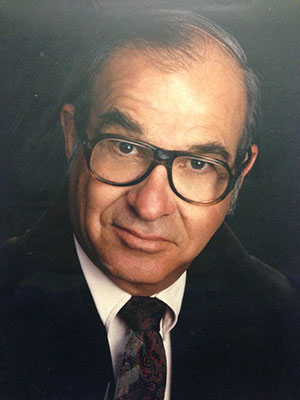Pediatrics
Dr. Robert Greenberg was a founding faculty member of the UNM School of Medicine and served as the Chair of the Department of Pediatrics from 1976-1987.
A native of St. Joseph, Missouri, Dr. Greenberg completed his undergraduate education at Stanford University and in 1953 received his M.D. degree from the University of California San Francisco, where he was awarded the prestigious Gold Headed Cane by his peers as the top student in his graduating class. Following residency training at Children's Hospital in Detroit, and a postdoctoral fellowship in pediatric endocrinology at State University of New York at Syracuse, Dr. Greenberg spent a year conducting endocrine physiology research at the Karolinska Institute in Stockholm, Sweden. He served as the director of the Division of Endocrinology and Metabolism at Stanford University and was the first chair of Pediatrics at the Martin Luther King, Jr. Hospital/Charles R. Drew Medical School.
Dr. Greenberg joined the School of Medicine Faculty in 1976. He received numerous honors, awards, and grants throughout a career that combined clinical medicine, teaching, biomedical research, administration, and extensive public policy and advocacy efforts. In 1984 he co-founded the Coalition for Children, a New Mexico child advocacy organization.
Bob Greenberg will be remembered for his passion for life, learning, travel, his wife and family, and advocating for child rights both domestically and abroad.


Dr. Greenberg was and will remain in our memories as a wonderful husband, father, teacher, physician, colleague, and friend. He gave much to us at UNM and he will be sincerely missed.
It gives me great pleasure to share my decades of recollections of Bob, an extraordinary role model of compassion and leadership dedicated to health care for all, beginning with our children. He accomplished this with wit and a piercing knowledge which made him a welcome addition in all of his interactions.
After the 1969 riots in Watts, California, Bob and his extraordinary wife, Maggie, “walked the talk” of caring by moving to Watts so he could chair the new Dept. of Pediatrics at the Martin Luther King Jr. Hospital. What better way to ask the question of how to make a difference for the children of disrupted communities? Another answer was his leadership in founding the Coalition for Children in New Mexico as he sought venues for improving health outcomes in our state.
He was as active in this commitment after his retirement from the UNM School of Medicine, as he continued community leadership in a host of formal and informal organizations including participating in the deliberations of our state legislature. Bob has been my colleague and friend since the mid 1970s, and I valued his vision and energy in a variety of health initiatives at the state level which continued up to the week that he passed away. A stronger and more reliable senior scientist-physician rarely comes along in the life of any institution, and Bob’s mark on healthcare will endure.
It gives me great pleasure to share my decades of recollections of Bob, an extraordinary role model of compassion and leadership dedicated to health care for all, beginning with our children. He accomplished this with wit and a piercing knowledge which made him a welcome addition in all of his interactions.
After the 1969 riots in Watts, California, Bob and his extraordinary wife, Maggie, “walked the talk” of caring by moving to Watts so he could chair the new Dept. of Pediatrics at the Martin Luther King Jr. Hospital. What better way to ask the question of how to make a difference for the children of disrupted communities? Another answer was his leadership in founding the Coalition for Children in New Mexico as he sought venues for improving health outcomes in our state.
He was as active in this commitment after his retirement from the UNM School of Medicine, as he continued community leadership in a host of formal and informal organizations including participating in the deliberations of our state legislature. Bob has been my colleague and friend since the mid 1970s, and I valued his vision and energy in a variety of health initiatives at the state level which continued up to the week that he passed away. A stronger and more reliable senior scientist-physician rarely comes along in the life of any institution, and Bob’s mark on healthcare will endure.